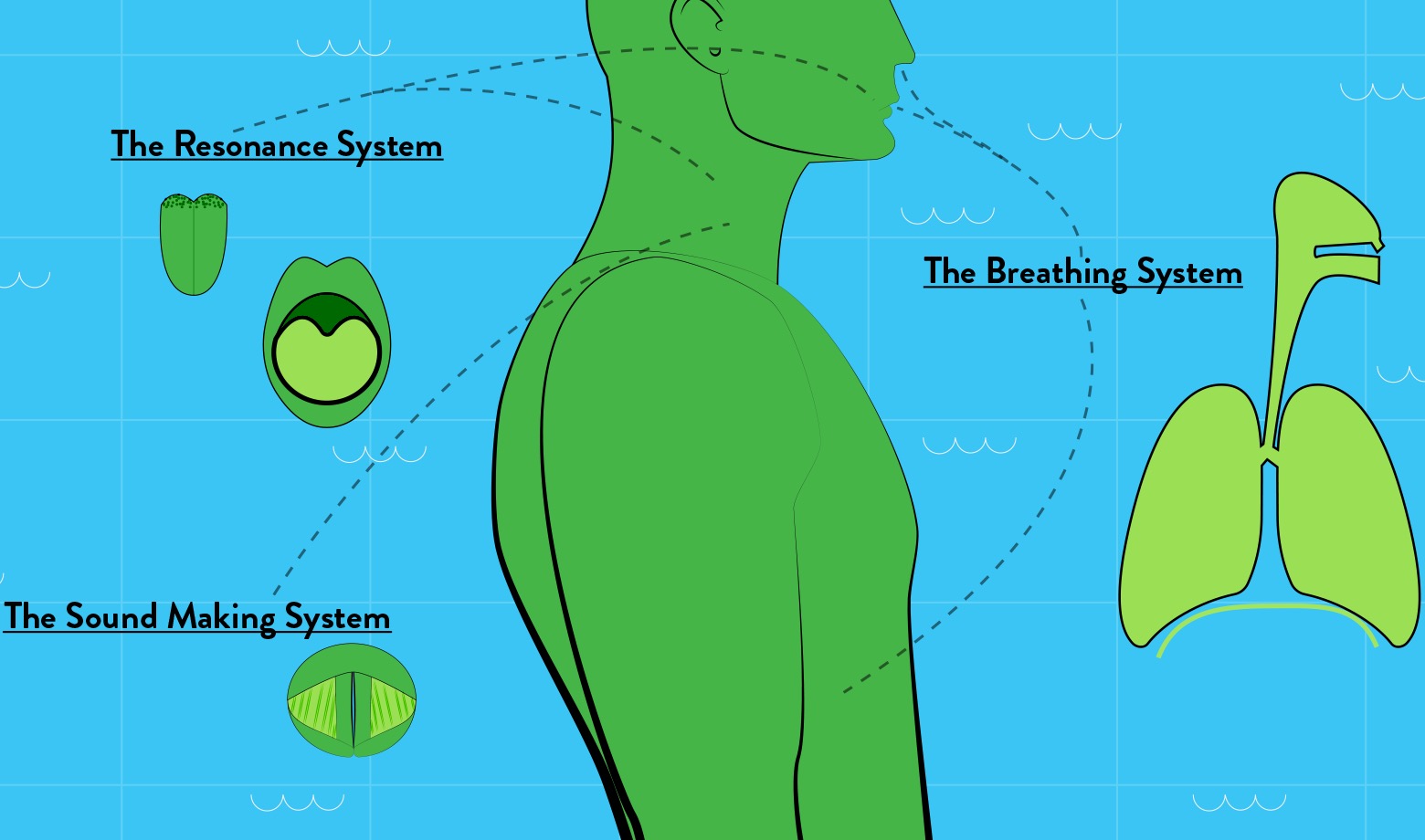
Body Mapping for Singers
Posted Monday, January 25th 2016 by Zac Bradford
An overview of the systems in the body that contribute to vocal sound!
An overview of the systems in the body that contribute to vocal sound!
Singing is by far the most personal instrument, as it is the only musical instrument housed in the human body. For the same reason, it is also the most difficult to master. Think about it… What other instrument are you expected to play without being able to see it and touch it, and in some cases, feel it. With a piano, you can look at a key, and know with certainty, that when you press that key you will hear a certain note.
With singing, we are required to play an instrument, most of which we cannot see or touch Not only that, but, the human voice is the only instrument that we simultaneously build while learning to play it. By build, I am referring to the strengthening and stretching of muscles (not only in the larynx, but the rib cage, abdomen, pharynx, oral cavity, nasal cavity etc.). Voice building also consists of increasing vital lung capacity, so that we have the necessary fuel to make sound. The “learning to play the instrument” part of the this process is also complicated, in that, we are coordinating muscles in many parts of the body, with air flow and resonance. As you can see, singing requires a highly athletic coordination of the human body. Let's take a look at some of these parts, so that you as a singer have a general road map of the parts of your body that contribute to your vocalization, and how they do so.
The Breathing System: Put simply, as we inhale, air enters the lungs through the mouth and/or nose. The muscles of the rib cage, abdomen and back can, through contraction and release, increase or decrease the size of the thorax, or the area where the lungs are. When the volume of the thorax/lungs increases, the pressure in the lungs decreases. When the volume of the thorax/lungs decreases, then the pressure in the lungs increases. This is important, because it has a direct influence on how the air stream coordinates with the vocal folds to make vocal sound, also know as phonation. The breathing system is often referred to as the Generator, because it generates the power needed to make vocal sound.
The Sound Making System: This system consists of the vocal folds and the air flow which is generated by lung pressure. This is referred to as the Source of sound. When the vocal folds are blown apart by the air flowing from below, they vibrate and create sound. The system also consists of the muscles in the larynx, which can directly affect the length, thickness, proximity of the vocal folds to each other and how much of the vocal folds vibrate. All of these variables affect the pitch, volume, consistency, the vocal timbre and the register in which we sing (head voice, chest voice etc.). There are also muscles that house the larynx, which can indirectly affect the aforementioned qualities of sound.
The Resonance System: Resonance is a back and forth relationship between the sound waves and the space in which they travel. These vocal resonances are influenced by the movement and configuration of the tongue, soft palate, lips, jaw, larynx and pharynx. The vocal resonators are responsible for articulating all vowels and consonants. Sometimes the vocal resonators are referred to as the Filter, because depending on the configuration of the vocal tract, certain parts of the sound wave get boosted and reach the listener and other parts gets deadened and die off before they leave the body. When certain harmonics get boosted and deadened, we the listener, perceive the tone or timbre a certain way. For example, when many higher harmonics are boosted we generally perceive a brighter sounding voice, and when lower harmonics are boosted we perceive a darker voice.
Over All Body Alignment: The way in which the body is aligned, from head to toe, can impact the way in which all three of the major systems function in the phonation, or voicing process. For this reason, it is important to know and practice a physical alignment that allows the Breathing, Sound Making and Resonance systems to work and interact optimally. It is important to state that alignment does not refer to a position or specific posture. Rather it is meant to reflect a neutral state from which a person has flexibility and freedom to access other stances, gestures and movements etc. An example of an alignment that could negatively affect vocalizing, would be hunching at the shoulders. Not only can hunching at the shoulders close in the chest, and contribute to diminished lung capacity, leaving a vocalist with less fuel at their disposal. But it can over activate muscles that house the larynx, which could potentially affect the way in which the vocal folds vibrate. This muscle activation could change the laryngeal position, which then directly changes the space in which the sound waves travel, in other words it alters the resonance. This is one of many possible scenarios, and doesn't take into account that the increased pressure in the thorax resulting from hunching could tempt the vocal folds to come together more firmly, which then affects the way they vibrates. There are many possibilities, depending on the anatomy and physiology of the individual.
I hope that it is obvious from this brief exploration into the human voice, that the vocal instrument is more than just some muscles in the neck. Rather, the voice requires coordinating a few major systems, which are all comprised of many muscles, bones, tendons ligaments and other elements. It is the functional unity of these systems and the overall alignment of the body, in which these systems are housed, that allow us as humans to vocalize. It takes time, mindful practice and heightened awareness to gain control of, and ultimately master this complex instrument that is the human voice.

Zac Bradford
Director of NYVC Australia/Voice Teacher Associate
Zac Bradford is the Director of NYVC Australia. His clients have reached the Top 10 on the Billboard charts, have been featured in Hollywood films, TV shows, have worked as backing singers for AAA touring artists, and are performing on Broadway, Off-Broadway, 1st US Tours, internationally, and more. His clients also perform in famous live music venues including Carnegie Hall, Lincoln Center, The Blue Note, Rockwood Music Hall and The Bitter End.

NYVC Singer Spotlight: Robin Avery
NYVC’s Jamie Kaufman had the pleasure of interviewing Miami-born singer-songwriter and psychologist Robin Avery, whose passion for music began at age four and continues to flourish today. Now writing and recording original songs with her partner of 25 years, Robin has found new vocal freedom and confidence through New York Vocal Coaching—culminating in her upcoming release, Old Friends, out this November.

NYVC Singer Spotlight: Jacqueline Baxter
NYVC's Jamie Kaufman had the pleasure of speaking with vocalist, producer, and classically trained flautist Jacqueline Baxter about her artistic journey, recent solo debut, and her work releasing music as “JAQ.”

Singing With Pure EEase
It’s time we had a talk about EE. Though it takes second place in the accepted listing of vowels, we use the EE to form the diphthongs of fourteen letters of our alphabet, making it one of the most...